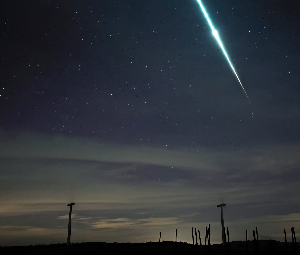Joy Allen captured a breathtaking fireball on March 22, 2025, at 02:50 GMT in Watchfield, England. Meteor season will kick into gear this July for the northern hemisphere. While the first half of the month will resemble June with mainly low meteor rates, a notable increase in both sporadic and shower activity is anticipated after the 15th. Meanwhile, southern hemisphere observers can expect a decline in sporadic rates, offset by the arrival of the Southern Delta Aquariids in the final week of the month.
During this period, the moon will reach its first quarter phase on July 2. At this time, it will be positioned 90 degrees east of the sun, setting around midnight on July 2-3. This weekend, the waxing crescent moon will set in the evening, allowing for optimal meteor viewing during the more active morning hours. Estimated hourly meteor rates for evening watchers this weekend are around 3 in mid-northern latitudes (45N) and approximately 4 in tropical southern locations (25S). For morning observers, estimates rise to about 10 meteors per hour for mid-northern latitudes and 13 for tropical southern locales. Actual rates will vary based on personal perception, local weather, and observer experience, with evening rates slightly diminished due to moonlight. It’s important to note that these estimates are based on observations from dark sky sites, as urban areas will only reveal the brighter meteors.
The radiant positions and rates detailed below are relevant for the night of June 28-29 and remain relatively stable throughout this period. Most star atlases, available both online and in bookstores, has celestial coordinate maps to help locate these radiants. Charts provided will show these positions for evening, midnight, and morning, centered on the sky directly overhead. These charts are designed for a southward facing view but can be adjusted for any direction by rotating them accordingly. For optimal viewing, meteors are best observed when their radiants are highest in the sky. Radiants that rise after midnight will not reach their peak visibility until dawn, making early morning viewing ideal.
Visible meteor activity will primarily originate from the following sources:
– The Anthelion (ANT) radiant is situated at 19:20 (290) -22 in eastern Sagittarius, 2 degrees southeast of the 3rd magnitude star Albaldah (pi Sagittarii). Best visibility occurs around 02:00 LST, with estimated rates of 1 per hour from the northern hemisphere and 2 from the southern hemisphere. These meteors have an entry velocity of 30 km/sec, indicating medium-slow speed.
– The Northern June Aquilids (NZC), traditionally a weak shower, will peak around July 1, with the radiant positioned near 20:28 (307) -07 in southeastern Aquila. Expected rates are around 1 per hour at their highest visibility around 03:00 LST, traveling at 40 km/sec, categorizing them as of medium velocity.
– The Microscopiids (MIC), active from June 25 to July 16, will reach their peak on July 3, with their radiant at 20:49 (312) -28 in northern Microscopium. Though expected rates are less than 1 per hour, they also travel at 40 km/sec, indicating medium-slow speed.
– The Phi Piscids (PPS), active June 21 through July 28, will peak on June 30. The radiant lies near 00:52 (013) +23 in southern Andromeda. Peak viewing is just before dawn, with estimated rates of around 1 per hour and a swift entry velocity of 67 km/sec.
– The c-Andromedids (CAN), observed from June 21 to July 15, will peak on July 7, with their radiant located at 01:17 (019) +44 in northern Andromeda. Estimated rates are less than 1 per hour, with meteors entering at 57 km/sec, classified as swift.
– The July chi Arietids (JXA), active from June 26 to August 6 with a maximum on July 17, are currently at 01:41 (025) +04 in southeastern Pisces. Viewers can expect less than 1 meteor per hour before dawn, with velocities at 68 km/sec.
Sporadic meteors, which cannot be tied to specific showers, compose the majority of nighttime activity outside major annual peaks. During this period in the mid-northern hemisphere, around 7 sporadic meteors per hour are anticipated in the final pre-dawn hour, reducing to about 1 per hour in the evening. In tropical southern latitudes, morning rates are expected around 9 per hour compared to 2 per hour in the evening, with urban locations yielding lower visibility.
The detailed table below summarizes these meteor showers, aiding observers in identifying potential meteoric activity. Careful observation parameters—such as duration and trajectory—can assist in determining whether a meteor corresponds to specific showers. The classification of meteor showers is based on their peak hourly rates, providing valuable insight for seasoned observers seeking to analyze and document these celestial phenomena. Activity rates and positions are specifically noted for Saturday night into Sunday morning.

